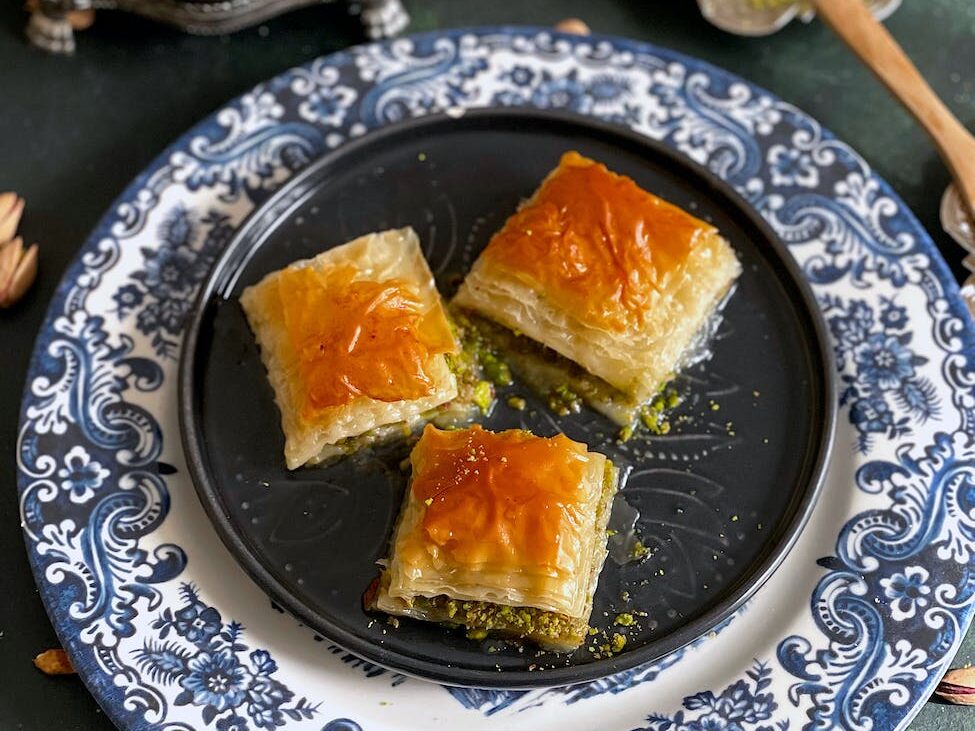| Prep Time: 10 minutes | Cook Time: 30-40 minutes | Total Time: 40-50 minutes |
| Servings: 6 | Yield: 6 popovers |
“Baklava is not just a dessert; it’s a sweet symphony of layers, a dance of phyllo and nuts, and a masterpiece that turns every bite into a moment of indulgent bliss.”
A fascinating fact about baklava is that its origins can be traced back to the Ottoman Empire, making it a dessert with a rich history that spans across various cultures in the Middle East, Mediterranean, and Balkan regions. The intricate layering of phyllo dough, nuts, and sweet syrup has evolved over centuries, and today, baklava is not only a delicious treat but also a cultural symbol of culinary craftsmanship and heritage.


Begin by preheating the oven to 350°F (175°C). In a mixing bowl, combine finely chopped nuts with ground cinnamon and set aside for later use. Ensure a 9×13 inch (23×33 cm) baking dish is thoroughly coated with melted butter.
Unroll the phyllo dough on a clean surface, covering it with a damp kitchen towel to prevent it from drying out. Start layering by placing two sheets of phyllo dough in the prepared baking dish, brushing each layer with melted butter. Repeat this process to achieve three full layers of double phyllo dough. Sprinkle approximately 3 tablespoons of the nut mixture evenly over the buttered phyllo layers.
Continue the layering sequence with additional phyllo sheets and nuts until the nut mixture is exhausted, culminating in a final layer of phyllo sheets. It is crucial to diligently brush each phyllo sheet layer with butter. Utilize a sharp knife to cut the baklava into uniform diamond or square shapes before baking.
Bake the assembled baklava in the preheated oven for approximately 50 minutes or until a golden-brown hue is achieved. While it’s baking, prepare the syrup by combining 1 cup of water, 1 cup of sugar, honey, and vanilla extract in a saucepan. Allow the mixture to simmer for approximately 20 minutes.
Upon completion of the baking process, promptly and evenly pour the hot syrup over the freshly baked baklava. Allow the dessert to cool thoroughly, providing ample time for it to absorb the syrup. Serve only when the baklava has attained a complete and uniform coolness, ensuring a sophisticated and indulgent culinary experience.

Ingredients:
- 1 package (16 ounces) phyllo dough, thawed
- 1 cup unsalted butter, melted
- 3 cups finely chopped nuts (walnuts, pistachios, or a mix)
- 1 teaspoon ground cinnamon
- 1 cup water
- 1 cup granulated sugar
- 1/2 cup honey
- 1 teaspoon vanilla extract
Instructions:
- Preheat your oven to 350°F (175°C).
- In a bowl, combine the chopped nuts and ground cinnamon. Set aside.
- Brush a 9×13 inch (23×33 cm) baking dish with melted butter.
- Unroll the phyllo dough and place it on a clean surface. Cover it with a damp kitchen towel to prevent drying out.
- Place two sheets of phyllo dough in the prepared baking dish and brush it with melted butter. Repeat until you have 3 full layers of double phyllo dough.
- Sprinkle about 3 tablespoons of the nut mixture over the buttered phyllo layers.
- Repeat the layering process with phyllo sheets and nuts until you run out of nuts, finishing with a top layer of phyllo sheets. Remember to brush each phyllo sheet layer with butter.
- Using a sharp knife, cut the baklava into diamond or square shapes before baking.
- Bake in the preheated oven for about 50 minutes or until golden brown.
- While the baklava is baking, prepare the syrup. In a saucepan, combine 1 cup of water, 1 cup of sugar, honey, and vanilla extract. Bring to a boil, then reduce heat and let it simmer for about 20 minutes.
- Once the baklava is done baking, immediately pour the hot syrup evenly over the hot baklava. Allow it to cool and absorb the syrup.
- Allow the baklava to cool completely before serving. Enjoy your homemade baklava!
Note: Baklava is best stored at room temperature and can be kept for several days.
-
Fry Bread
The origins of Navajo fry bread are closely tied to a dark period in the history of the Navajo people. In the 1860s, the U.S. government forcibly relocated the Navajo Nation, a Native American tribe, from their ancestral lands in Arizona and New Mexico to Bosque Redondo, an internment camp in eastern New Mexico. This…
-
Grilled Lemon Herb Chicken
With each flip and sizzle, your kitchen transforms into a culinary haven. Once cooked to perfection, these grilled lemon herb chicken breasts are ready to steal the spotlight in your wholesome and flavorful dinner.



